 EPHËMERIS EPHËMERIS
ODENSE 2003
|
GOING TO ODENSE
Being part of a group who was going to Odense not
only to see the exhibition in the Museet for Fotokunst but also
to finally meet each other in person, I left Hamburg by train
on thursday morning in overcast and cool weather. Expectations
were high, and for me meeting a lot of women I only knew from
the web was at least as important as finally getting a closer
look at Viggo Mortensen's art (and maybe The Man himself). The
train ride was uneventful inspite of delays, and when we arrived
in central Fyn we were greeted by a brilliant blue Danish sky,
hot weather, and a beautiful and very Danish town. Fyn is the
island situated between the mainland and Sjælland, the
island where Copenhagen is. (Viggo's family is from Sjælland.)
Odense is birthplace of Hans Christian Andersen
and Denmark's third-largest city - the fairy-tale capital of
Funen (Fyn), home of 200,000 people and with a history stretching
back over 1000 years (this information comes straight from the
city's website). Right in the middle of Odense is Brandts Klædefabrik,
which was for more than a century one of the largest employers
in Odense. In 1977, the cloth mill was closed, for a few years
it was vacant, and then it was gently renovated to become Denmark's
first international center for art and culture. It houses the
Danish Graphic Museum, the Museum for Photographic Art, several
galleries, and a bookstore.
Taking up residence in the Youth Hostel right next
to the train station we met others from our group, most of whom
we had never seen before. To be able to find each other we had
agreed on wearing a button with a pink pawprint, a sign representing
the Farthest Outpost, the board we are all on. In all we were
almost 20 people, and we knew there would be more from other
boards in town, too. We were hoping to meet at least a few of
them in the days to come.
The first day passed with getting to know each
other, getting to know the town - and finding the way to Brandts
of course, the place where the exhibition was going to open on
friday night. On our way there we saw the first posters for the
exhibition, one with Chris' dogs and one with Topanga
#7.
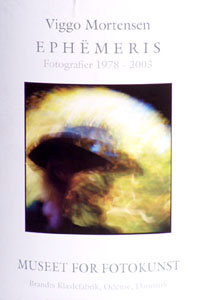 We
found Brandts within walking distance of our temporary home.
On the ground floor there is a bookstore, and here we had our
first glimpse of 45301. There was a stack of the new books,
and of course everybody wanted it. The pile was gone pretty soon,
but the friendly and very helpful staff produced more boxes of
books, facing the first onslaught of what was going to get much
crazier during the following days. A new book is always a promise
of pleasures to come, and one awaited with so much anticipation
has quite a lot to live up to. Some of us were taking a first
look right then and there, others were saving it for later. There
was a flyer announcing the exhibition, too, with Hindsight
#2 on it, and the museum's new catalogue which has Erfoud
#5 on the cover and 16 pages of photos and text covering
Ephëmeris (ephëmeris - Greek for diary, log).
So with the posters, books and catalogues we had our first shopping
expedition complete and retired to the park to get a good look
at 45301. We
found Brandts within walking distance of our temporary home.
On the ground floor there is a bookstore, and here we had our
first glimpse of 45301. There was a stack of the new books,
and of course everybody wanted it. The pile was gone pretty soon,
but the friendly and very helpful staff produced more boxes of
books, facing the first onslaught of what was going to get much
crazier during the following days. A new book is always a promise
of pleasures to come, and one awaited with so much anticipation
has quite a lot to live up to. Some of us were taking a first
look right then and there, others were saving it for later. There
was a flyer announcing the exhibition, too, with Hindsight
#2 on it, and the museum's new catalogue which has Erfoud
#5 on the cover and 16 pages of photos and text covering
Ephëmeris (ephëmeris - Greek for diary, log).
So with the posters, books and catalogues we had our first shopping
expedition complete and retired to the park to get a good look
at 45301.
The new book is an exercise in abstraction. Aside
from the imprint and a list of pictures there is virtually no
typeset text, not even page numbers - but there is a lot of handwritten
text, in layers, reversed, inverted, huge, tiny... most of it
just beyond legibility, constantly teasing with snippets of sentences,
words, scribbles. Embedded in this maze of thoughts and quotes
are the photos, as abstract as you can get without leaving the
medium photography behind. It is a beautiful and provoking book,
a pleasure and a challenge.
THE OPENING
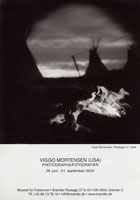 The next morning Odense greeted us with another
hot and dry day, so I had definitely packed the wrong clothes
and had to go shopping for T-shirts. We explored the town and
got to know each other better. Our group consisted of 19 women
between 13 and mid-fifties from seven nationalities, and it was
an amazing experience to see how close we got in such a short
time. It was wonderful to finally put faces to names and to really
talk to people we had known for quite a while now on the board. The next morning Odense greeted us with another
hot and dry day, so I had definitely packed the wrong clothes
and had to go shopping for T-shirts. We explored the town and
got to know each other better. Our group consisted of 19 women
between 13 and mid-fifties from seven nationalities, and it was
an amazing experience to see how close we got in such a short
time. It was wonderful to finally put faces to names and to really
talk to people we had known for quite a while now on the board.
The opening was supposed to be a t 19:00, doors
would open at 17:30, admission by ticket only. The museum's staff
had braved the overwhelming wave of emails for weeks, trying
to deal with a situation they were probably neither expecting
nor prepared for, but everybody was friendly and helpful. There
was some security personnel in addition to the permanent staff
- perhaps the constant flood of emails had resulted in a certain
amount of fear of hordes of hysterical women about to storm the
gallery
The tickets were given out by number and name,
and we could go up the staircase to the first floor to wait in
front of the gallery, where the exhibition was still behind closed
doors. Slowly a group of waiting people was forming, and as the
day outside was still unusually hot, and Brandts has tall windows,
the room was getting stuffy soon. Several of the staff members
were wearing Viggo's T-shirts with "War is not the answer",
and one of them had a target drawn on it where it stretched over
his belly, with "Thanks for all the help, Jørgen,
Viggo" written on it - so obviously the artist had already
been at work...
We were waiting more or less patiently, and met
a group of four american women who had been mentioned in the
press for having come all the way from the States to see the
exhibition. After a lot of fanning with the beautiful cards that
served as flyers for the exhibitions but had been used as invitations
and tickets for the opening too, and the brave attempt of two
gentlemen to open more windows with insufficient tools, the door
to the gallery opened, and we were allowed in.
We had a first look at the exhibition - there were
many familiar pictures, and even more new ones, but the room
was hot and crowded, and concentration was hard to come by at
that time. There were close to a hundred pictures, more than
half of which I had never seen before, and I was glad to know
that I would have time to come back repeatedly. After a while
the crowd started to drift towards the back of the gallery where
a mike stand indicated that this was where the speeches were
going to be held. We were by that time closer to the entrance
and decided to stay there, because the air was already very stuffy,
and the mass of people standing in front of the microphone was
standing pretty dense.
I saw Pilar Perez looking into the gallery from
the hallway, and then she came in with Viggo and his son Henry.
Viggo was without the beard we had seen on pictures from NZ,
his hair looked like it had survived a last minute attack with
a brush, he wore black jeans and a grey shirt. Oh - and shoes,
too. Nobody had reason to complain about the lack of colourful
shirts though, because Henry held up the reputation of the Mortensen
men with a yellow/brown/orange piece that looked like straight
out of the 70s. Viggo was looking tense, like he had to take
a deep breath to take on this room full of people, he was looking
mostly down or at Pilar, and they walked quickly up to the microphone.
First a gentleman held a short speech which gave
the non-Danish guests ample opportunity to hear how the name
Viggo Mortensen is pronounced in Danish. I think it was Finn
Thrane, the director of the Museet for Fotokunst, and next was
Lis Steincke, the curator. In the excitement of the day she had
lost her manuscript, and it took a minute until somebody from
the staff came through holding up the page with her speech to
a round of applause. When she had finished it was Viggo's turn
to step up to the mike. He was barely visible from where we stood,
and he was talking too low for me to understand much. He was
speaking Danish for the first part of his speech, a little nervously,
laughing now and then. He ended but then returned to the mike
to thank Henry for his patience. Obviously he had done so in
Danish, and wanted to say it in English again so Henry would
understand it. There was a short round of applause, and then
people were milling around where Viggo was. Suddenly he walked
out onto the balcony that runs along the house in front of the
gallery, and most of the crowd rushed out in pursuit. Those of
our group who had not been so lucky as to get a ticket and were
standing in the square in front of Brandts saw Viggo come out
onto the balcony, then standing with his back to the railing.
When the crowd was rushing at him he was pressed back against
it, staying there writing autographs.
We didn't feel comfortable about adding to the
pressure and stayed back inside the gallery, getting a closer
look at the pictures now that the room had emptied a little.
Slowly the group that had rushed him outside dispersed, quite
a few of them leaving with their autographs without taking further
notice of the exhibition, which I found a little sad. But the
atmosphere, that had been quite tense for a while, lightened.
Viggo was still out on the balcony, but now he was able to move
around, and seemed a lot more relaxed than before. He was talking
to people, laughing, greeting what seemed to be friends and family
with embraces.
There was a boy stepping up to him, explaining
something, and Viggo drew something on his arm like a tattoo.
It said, "Til Super-Mikkel (heart) Viggo". Candy, who
understands Danish, told me that the boy's name was Mikkel, the
same as in one of the photos.
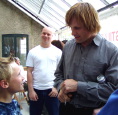 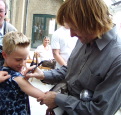 
Viggo & Mikkel
Viggo was focussing on everyone who approached
him, giving each person the impression that they had his full
attention at least for the moment the encounter lasted.
When Candy stepped up to him to give him something
she had brought, among other things beer, and explained about
it being from the northernmost brewery in Norway, mentioning
the name of the place, he told her that he had been there, and
explained at length (and with a lot of gesturing) how he had
got there. She got into the spirit of it, and they both were
drawing maps in the air, showing each other which way from lapland,
which fjord to cross, and which polar bear to avoid to get there.
All the time he held on to the beer, and in the end he thanked
her for the gifts and kissed her, so she went back into the gallery
in quite a haze.
  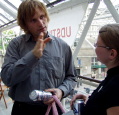  
Viggo, Candy & Norse beer
He stayed on the balcony for longer, still signing,
while everybody else was either having wine and hors d'oeuvres
in the hallway, chatting, or looking at the exhibition. Eventually
Viggo came back in, posing for a few press photos, first with
the director of the museum, then with Mikkel, who proudly presented
his "tattoo". By that time security kindly but firmly
ushered the guests out, and the gallery was closed for the public
for that evening.
I think it was a pity that Viggo was "reduced"
to being a movie star by the almost instant rush for autographs.
He should have been given a little more time and space to be
the visual artist he was on that evening, the one whose exhibition
was opening.
Odense is not really a small town, but maybe the
sudden invasion by at least 300 people caught everybody by surprise
- we did encounter a few hiccups when it came to getting room
and food for almost twenty people in cafés and restaurants.
We ended the day of the opening with a chinese dinner and talked
about the exhibition and the opening, and later joined the rest
of the group in a café for beer and more talk. Somebody
bought a newspaper with an article about the exhibition, and
the night ended in front of the computer in the basement of the
Youth Hostel, giving at least a sign of life for the community,
even though everybody was much too keyed up and tired to post
a coherent report.
THE EXHIBITION
The next day was saturday the day of the
reading in Magasinet, a theater opposite Brandts, and the book
signing that was supposed to follow. These events required tickets
for admission too. The reading was scheduled for 17:00, so we
had time to start the day at the gallery, and everybody finally
got to see the exhibition. In the line already forming at the
entrance to Brandts we were happy to meet the last "unknown"
member of our group.
Staff at the museum was as kind, organized, and
friendly as on the day before. Admission fee to Brandts is amazingly
low, and if you only want to see Ephëmeris it is even cheaper.
This time we could do the exhibition justice. It is spanning
the time from 1978 to the present, 93 pictures in all, more than
half of them shot during the past two years. The gallery itself
is well lit and spacious, nothing distracts from the pictures
on display. All the photos are framed in blond wood (maple, as
Pilar Perez told us at the opening). It was good to finally see
familiar pictures "for real", several of my favourites
were there, but it were the new ones that blew me away.
Some of our group were lucky and got a special
tour of the exhibition with Lis Steincke, the curator. She explained
the origin of the circle shape of a lot of the pictures (you
see one on the cover of Un Hueco en el Sol at PP's website).
Turns out it is the result of yet another broken camera, this
time a damaged lens in the Hasselblad (an information that made
me happy, because I would have hated for it to be just Photoshop...)
We had read how Lis Steincke got the idea to invite Viggo to
do this exhibition: She went (reluctantly) to see LOTR, was intrigued
by the actor portraying Strider, accessed Google, typed in "Viggo
Mortensen", hit "search" and then found
out he was much more than just an actor. Sounds kind of familiar,
doesn't it?
 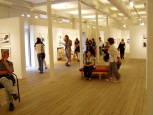
The exhibition room
I am not an art critic, and indeed am not even
good at dissecting pictures. Being a photographer myself I have
the fatal tendency to look at the "how" more than at
the "what". I am learning to leave that behind though,
because I think that it blocks the access to what a picture is
about. I am not really a very technical photographer, but still
I find myself wondering "How did he do that?", when
probably the better question is, "Why did he do that?"
The more I turn away from technicalities the more am I falling
in love with abstract photographic images. So if in the following
I am offering sometimes more a glimpse at what the new pictures
triggered than a description as such, please bear with me.
The first group of new pictures consists of Marrakesh
and Marrakesh#2, Hindsight#59 South and South#2,
and Erfoud#33, all of them black and white. Which is where
the similarity stops already... The two Marrakech pictures are
shapes of trees moving past the eye, blurring but still compact,
very different from Sueño del Retiro with its shifting
greys. Here the trees dissolve into a violently moving pattern.
Hindsight#59 horses tied among ruins,
on the ground footsteps leading to where the photographer must
be standing. The whole picture like something from a very old
movie, or a very fresh dream.
South and South#2 - grainy and blurry
images of figures standing at the road side watching. They look
like memories of past lives, their features blurred.
Erfoud#33 taken in a completely different
century. A print of running horses, sticking behind a lamp? taillight?,
the white wall it is on vertically dividing the picture in two
uneven halves, with the view of a landscape and part of a tank
truck. So many associations triggered, all of them left hanging
in mid-air, a picture in a picture
Then, following a group of familiar photos, Go#16
and Hindsight#32. A portrait of a tree in sharp focus,
and next to it the dream wood with two running horses that could
easily be unicorns. More well known faces, and then
Noon#2,3. Strong colours, two overlapping
frames, shot straight into the glaring sun, with a horse's head
moving between the camera and the blue sky.
Then, a little later, Hacia Mariel. A grey
blue sky with a hint of landscape at the bottom of the frame,
passing by before it can be recognized, the main emphasis on
the leaden clouds, all of it more an impression than depiction.
Fototeca and Fototeca#2. Here is
no warmth left, just the white of the sky streaking over the
bluish forms of palm fronds and shuttered windows, dissolving
them into an abstract pattern, or in #2 a strong circular
movement with the same cool colours, drawing the eye into the
center.
Erfoud#4 and #5 - two variations
on a theme. #4 was on Perceval Press' homepage for a while,
on first look a view through arabian arched windows, out on a
town and blue sky, which then turns out to be a deteriorating
wall of which the blue paint is peeling, while the "windows"
are made up of the silhouette of arches the sun is projecting
on that wall.
Erfoud#60 - intense red of a wall with strong black pattern
of a tree's shadow over it.
Hoka-hei, the fleeting dusty impression
of riding, the red in the center almost pulsing.
Topanga#7, which is on one of the two posters
for the exhibition. A self portrait, one of the circular images,
the profile almost drowning in flickering yellow and green.
Grandview suddenly we are back in
the world, only to find ourselves in the shadow behind an overgrown
picket fence, a treacherous idyll filled with darkness.
Hos Farfar (at grandfather's) - a portrait
of Henry sitting in a shadowy garden.
Christmas#2 - again the shadows, this time
with a bright light on the needles of a tree.
Erfoud#11, the blaze from a hearth lighting
just an arm holding a copper pot, almost a monochrome if it were
not for the blue of the sleeve. Another picture that looks like
culled from ancient memories.
Morning#3 - at the bottom of the circle
a bleached jaw bone, at the top the silhouette of dunes with
two figures standing before the pale sunrise sky. In this case
the circular image doesn't lead the eye into the center, the
center is just the space between the bone and the backlit figures.
A strange balance between bleakness and hope.
Hindsight #2, which was on the flyer and
the tickets. A b&w view of a teepee before a sunset sky,
seen over the flames of a campfire. A deeply melancholy picture,
very beautiful. Here the circular shape works like the vignette
in an old photo.
Hindsight#24/25 two overlapping shots of
a paint horse with rider, shot against the sun. The light is
stinging in your eyes, making it hard to see the face of horse
and rider.
Hindsight #48/49 two pictures showing a
teepee village, again with the campfire in the foreground. In
one of them you see people in american natives costume, and again
that feeling of sadness and loss, the blurriness enhancing it.
Hindsight#43 the teepee village seen over
the barrel of a canon. No soft circle this time, but the clinically
harsh square of a full negative. A scary view.
Ride#29 - is at the time being on the home
page of Perceval Press. The rich reddish tone highlighted with
the golden reflexes is beautiful.
Hindsight#75 a colourful sunset sky with
silhouettes of several people in costume, in the foreground one
in traditional american native clothes. The light from the sky
is bleeding into the bodies' outlines, dissolving them.
North#6 the glow in the middle of a campfire
where it is hottest - you almost feel the moisture on your eyeballs
dry out looking into it. It has all the hypnotizing power of
a real fire when you look into it and get lost.
Hindsight#53 a view of the teepee village,
this time in strong colours, shot straight into the sun, the
reflections forming a corona around the light in the center and
the teepees, colour is bleeding into the dark parts of the picture.
It looks very much alive.
Wild#13 a hand holding food out to a horse,
the viewpoint of the camera is low, like from a crouching position,
and the horse is standing ready to bolt, but intrigued with the
bait. The picture draws me into the situation, I want that horse
to come closer
Ride#2 the horizon divides it into the black
foreground and a brilliant blue pre dawn (or post sunset) sky
with a few dramatically lit clouds. At the right side is the
silhouette of a horse's head, and it could be the idyllic view
of a solitary ride if it were not for the movie spotlight and
the technician standing beside it that we find at second glance...
23 November#6 roadkill again... with the
rear lights of of cars blurring in the background (at least now
I know what VM did on my birthday last year - I had been wondering)
Hindsight#79 view of the teepee village,
but this time in colour, with campfires under an overcast sky
and people moving. Still the sense of times past, but with not
such a deep melancholy as the b+w ones
And then what I eventually felt to be my favourite
photos - three of the Mielo series. Big prints, colours
in layers, shifting and blurring. We asked Pilar Perez for the
meaning of "Mielo", and she replied, " In Lakota,
it means "It is I" and is from a Ghost dance song."
In the photos Mielo#11, 4, and 9 you see figures
moving, and a lot of empty space, the feeling of wide plains,
deep memories. They are the kind of pictures you can stare at
for a long time because they leave a lot to you, to decide what
you see, and how you see it. They are beyond photography (can
you tell I was impressed?)
Retreat#4 two riders wearing turbans and
behind them a dramatically orange and blue sky - actually it
is more an abstract though, with strong shapes and colours
Retreat#9 a paint horse's head as seen from
the rider, lit by flash, thus giving it light and colour, with
a background of a night sky with the last remnants of a sunset
(or sunrise). This description doesn't do it any justice though
- it has some magical qualities that require a better pen than
mine to be evoked - just go and see it.
Ride#31 blurry layers of soft orange and
other warm colours, riders passing in front of a bright light
Ride#46 a single rider silhouetted against
a rose glow, a palm tree looking almost like fireworks in the
artificial light
Ride#71 neck, ear and mane of a paint horse
(which of course is the one "playing" Hidalgo), a hand
on the reins, and on the ground visible the shadow of horse and
rider. A beautiful shot, close up and long shot in one.
Ride#28 the head of the horse, not much
more than the eye actually, seen in front of a river under an
orange sky.
Topanga#24 a circular picture again, something
like seen by an ant, parts of a plant/tree up close, more branches
further up , and over it the sky.
Cheyenne River#3 almost startling in its
clear colours, and its details in sharp focus. Again shot from
ground level, but this time the eye goes to the horizon, not
up into the sky. Colours of autumn.
Hindsight#84 a dreamily beautiful landscape,
bare trees, snow, a blue sky, hazy ground
Nearly#5 close up of leaves, with the light
shining through them, b+w and quite abstract
Nearly#4 a similar shot, leaves and light
criss crossing the picture within the boundaries of the circle
Vor#5 (vor = icelandic for spring) one of
my favourites - the circle is filled with the blurry image of
the sky overhead, a few branches on the edge of the picture,
and a flock of birds rising out of them
Hindsight#22+21 two circular b+w of a snow
encrusted ground with leaves, and the long shadows of bare trees
falling over it. They both work fine as abstracts, too.
Erfoud#15 another close up of leaves, this
time in colour, the strong light dissolving the reality
Erfoud#14 dusky pink roses with a sky of
intense blue and a silhouette of a palm tree behind them - a
weird shot with absolutely otherworldly light
Erfoud#17 the ant perspective again, this
time with flowers (bougainvillea? I have known to be wrong...)
on the fringes of the circle, a cloudless blue sky, and the glare
of the sun
Erfoud#16 (on the cover of Un Hueco en
el Sol)
Hindsight#81 reddish light from a low sun
lighting bare trees before a cloudless blue sky. The contrast
of the warm colours and the cold feeling is weird and intriguing
Ride#53/54 overlapping frames of circular
pictures, one of the shadows of three horses and two men on the
ground, positioned almost like hands on a clock, converging in
the center of the circle, the other a close up of a horse's mane,
almost orange. A strong and very abstract double image.
Rachid's#5 two overlapping frames, the one
of Viggo's jaw, mouth, neck, the other of a man stroking a cat.
b+w, mysterious.
There are three pictures in the catalogue that
didn't make it into the exhibition:
Blue#4, from Hole in the sun
There#3 a b+w self portrait (again only
mouth, part of his Frank Hopkins costume) and the partly visible
horse with saddle
Hindsight#9 a view out of a teepee, with
a woman in American Native traditional costume, photographing
the photographer
THE READING
After leaving Brandts we got in line for the reading.
It was another hot day, so everybody was grateful for the growing
strip of shadow alongside the wall of Magasinet. We were lucky
to be such a big group, as we could walk off for a while and
then return to the line. Perhaps the fact that we were the first
in line and were so many caused irritation, or it was that we
had made ourselves at home, including jewelry workshop - we received
a few strange vibes from other people in the line. I regret that,
as we all were there for the same reason, but there was not much
we could do about it as we were not sure what caused it. Unfortunately
people soon joined the line from both sides, which was not such
a good idea.
 
Waiting in the line
We had been watching through the glass door as
the museum staff set up tables in the foyer, stacking some 300
personalized tickets (the flyer again), briefing security. When
the door finally was supposed to open there was a little hiccup
because it was stuck, but they managed to free it, and of course
the dreaded pushing set in, from both sides of the line. But
security let in only a handful at a time, so it worked out eventually.
People went upstairs into the bar/café leading
to the entrance of the auditorium, and there we were stuck for
quite a while, maybe the only slip in the otherwise excellently
organized events. It ended with a hot stuffy room full of people
thronging in front of the doors to the auditorium, so when we
finally were allowed in there was some serious pushing again.
It had to be expected, as only a few lucky ones had reserved
seats in the five front rows, and the rest was eager to get as
close to the stage as possible.
The place filled up quickly. The air was thick
to begin with and of course got worse soon, with more than 300
people inside, and a hot day outside. The open doors didn't help
much because on one side they were only leading out onto a staircase,
and only when somebody opened the downstairs door leading onto
the street there was a little bit of fresh air coming in. Soon
the flyers came into use as fans again.
The red curtain across the stage was drawn, and
there was a mike stand to one side in front of it. At about 17:15
Lis Steincke, the curator, stepped up to the mike and gave a
short introduction, while behind her the curtain opened to show
a small table center stage, with pink roses, a few books and
notes, bottled water and mate cup, a mike, and Viggo. Black jeans,
dark long sleeved sweat shirt and over it a "war is not
the answer" T-shirt, bare feet. Of course there was a barrage
of flashlights going off, which resulted in Lis' total confusion.
Viggo was unfolding a big UN flag and covered the table with
it, and then he bit off one of the roses, hid it behind his back
and walked over to Lis Steincke. When she had ended her introduction,
asking for all electronic equipment to be shut off during the
reading, he presented her with the rose and gave her a hug.
 
Listening to Lis Steincke's introduction
Viggo sat down, and started the reading by saying
a few words about his reading in Danish, saying, "For those
of you who understand Danish you might not understand mine."
When talking about the Danish translation of his poems for Nye
Falsknerier he asked the translator, who was sitting in the
audience, to please stand up, and thanked him for his work.
The first poem he read (in Danish) was Cuttings.
I guess that most of the audience was not Danish, and those who
were were maybe not familiar with the poem there was that
slightly uncomfortable pause when the poem was over, but nobody
was quite sure if it was. Viggo shrugged and laughed a little,
looked at the translator and joked, "This was not what I
meant." He then continued with Stones, Matinée
and Nebraska - all of them in Danish. I could see
his bare feet under the flag - whenever he was speaking or reading
Danish he was moving his feet like they were the outlet for his
nerves. Then he read a poem by Søren Ulrik Thomsen and
said that he wanted to read it because he likes it (all this
in Danish too).
 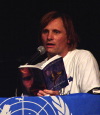
Reading Nye Falsknerier
I have to mention that contrary to the day before
at the opening it was no problem to hear him - he was taking
care to speak into the mike, and it had been installed by somebody
who knew his trade, so thank you to the unknown sound engineer
Shuffling his books and notes he stated, "I have some order
actually let's see how long it lasts." Followed in
Danish Edit, Lunch ("her version"), Lead
which he introduced by talking about the time he worked at a
factory in Glostrup in Denmark at age 20. He dedicated it to
all Danish metal workers. He then read a couple of Danish haiku.
The next text he picked up from the table was a
hand written page where the writing was covering the whole paper,
sneaking around the corners, leaving hardly any of it free. He
started reading in Englsih and it was Back to Babylon.
He read it with strong emotion, ended it, looked a little confused
for a second and then said that he had left out a line.
  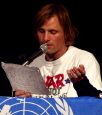
Reading Back to Babylon
Then he sang an Argentinian song, Silencio.
He sang a capella of course, and the room was suddenly very quiet.
I know that a lot of people had a lot of doubts about whether
or not he can sing - well, he can. It was hauntingly beautiful,
and even though hardly anyone will have been able to understand
the words we heard the deep emotion of the song. (the text can
be found www.planet-tango.com
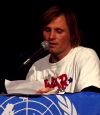 
Singing Silencio
He made several anti war statements, and then he
talked about New Zealand, praising the country and the people.
He read several poems by the following New Zealand poets (I hope
I got the names right, sorry if not): Jeanette Stayes Camera,
Gregory O'Brien, Bob Orr, M. K. Joseph, James K. Baxter.
Then he dedicated Fossils to all the people
of Afghanistan and Iraq and read it, followed by Hillside
and Mermaids - this last one in Danish. This ended the
reading, and while everybody was applauding he picked up his
camera, walked closer to the edge of the stage and took a picture
of the audience, moving his camera (lots of interesting streaky
flashlights I bet). Then he went to sit at the table again, and
the signing started.
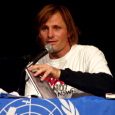
Reading from
Coincidence
of Memory
|

Shooting
back
|
THE BOOKSIGNING
It had been established earlier that those sitting
in the back were supposed to go up on stage to have their books
signed first. We had been asked to take two slips of paper, write
on it what we wanted Viggo to write, and not to ask for having
more than two items signed. It was very soon obvious that hardly
anybody stuck to that, and also that Viggo didn't refuse to sign
anything. We were in for a long wait, because the line advanced
only slowly, and we were sitting in the fifth row.
Soon there was a pile of presents on the table
and on the floor, and Viggo offered some of the chocolate he
had been given. At one point a woman looked at the chocolate
and declined, saying something that made him look surprised.
Although he was eating from the chocolate too, he obviously hadn't
yet tried that particular box. He took one, had a small bite,
looked extremely dubious, and put the box away, opening another
one.
 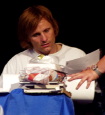  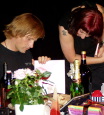
He had drained a bottle of water right after the
reading, and had beer and later wine while he kept signing. He
was concentrating on the person on stage, hardly ever looking
into the audience (perhaps the prospect of all those people with
all those books and expectations was too daunting to dwell on).
There were a few security people on stage and in the aisles,
but they didn't have much to do. A few things happened to break
the routine though:
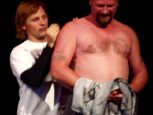 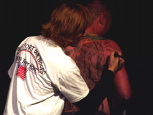
There was a man who had a big LOTR tattoo covering
his entire back, and he had Viggo sign it (we later read in a
newspaper that he had him sign it in indelible ink to have it
tattooed too). A woman said something to him about the "War
is not the answer" T-shirt, and he took it off, signed it
and gave it to her. I later saw that the sweat shirt he wore
had Lord of the Rings / stunt team on it.
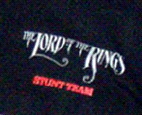 There was a blonde toddler whose mom let him run
around on the stage for a while, and at some point he walked
up to the table, and Viggo presented him with some chocolate,
which earned him a big surprised stare. Then Viggo took a piece
of chocolate himself and demonstrated how to take a bite and
eat it, but the baby just wandered off, chocolate in hand
only to turn round a moment later and take a bite, and then run
back to his mom. Viggo kept signing, he signed books, posters,
flyers, bellies and arms Quite a few ladies had no compunction
about asking for a kiss, and received one, some kind of Kiss
On Demand thing which I found really intrusive. There was a blonde toddler whose mom let him run
around on the stage for a while, and at some point he walked
up to the table, and Viggo presented him with some chocolate,
which earned him a big surprised stare. Then Viggo took a piece
of chocolate himself and demonstrated how to take a bite and
eat it, but the baby just wandered off, chocolate in hand
only to turn round a moment later and take a bite, and then run
back to his mom. Viggo kept signing, he signed books, posters,
flyers, bellies and arms Quite a few ladies had no compunction
about asking for a kiss, and received one, some kind of Kiss
On Demand thing which I found really intrusive.
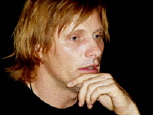 We were not really happy about the music that
was being played over the speakers, but later somebody said that
Viggo had picked it - maybe it was helping him to stay awake.
He was looking really tired after a few hours, he never left
the stage, he didn't have a break of any kind. The signing went
on for more than five hours, and as we were among the last ones
to go up on the stage we could see that he was really exhausted,
but still he tried to be as attentive as he could. We were not really happy about the music that
was being played over the speakers, but later somebody said that
Viggo had picked it - maybe it was helping him to stay awake.
He was looking really tired after a few hours, he never left
the stage, he didn't have a break of any kind. The signing went
on for more than five hours, and as we were among the last ones
to go up on the stage we could see that he was really exhausted,
but still he tried to be as attentive as he could.
EPILOGUE
We went to see the exhibition one more time on
sunday, and while we were there Pilar Perez came in. She talked
with a few people and said that Viggo was there. She came back
a moment later to say that he was still feeling really drained
and would appreciate it if people would let him do what he had
come for (something with Sueño del Retiro, and
picking up a picture that hadn't made it into the show) and leave
him alone. Inspite of this there were several people who pounced
on him, and he left.
Somehow the four days were over far too soon, and
we had to say good bye to people who have become far more than
just women we know from a message board. I will go back to Odense
later this summer with friends to see the exhibition again, and
the reading was a beautiful experience. I am not sure if I want
to go to a signing again, but I would not miss the Odense Experience
for anything.
Thank you to Candy who wrote down which poems
Viggo read and a synopsis of what he talked about when speaking
Danish, to Naja for asking about Mielo, to Betty for the
link for Silencio, and to Daz for the tickets.
A big Thank You to the staff of Museet for Fotokunst in Odense
who made this possible and were kind and helpful through all
of it, and thank you to Viggo Mortensen for being who he is.
Text by Mackie/The Farthest Outpost
|



 There was a blonde toddler whose mom let him run
around on the stage for a while, and at some point he walked
up to the table, and Viggo presented him with some chocolate,
which earned him a big surprised stare. Then Viggo took a piece
of chocolate himself and demonstrated how to take a bite and
eat it, but the baby just wandered off, chocolate in hand
only to turn round a moment later and take a bite, and then run
back to his mom. Viggo kept signing, he signed books, posters,
flyers, bellies and arms Quite a few ladies had no compunction
about asking for a kiss, and received one, some kind of Kiss
On Demand thing which I found really intrusive.
There was a blonde toddler whose mom let him run
around on the stage for a while, and at some point he walked
up to the table, and Viggo presented him with some chocolate,
which earned him a big surprised stare. Then Viggo took a piece
of chocolate himself and demonstrated how to take a bite and
eat it, but the baby just wandered off, chocolate in hand
only to turn round a moment later and take a bite, and then run
back to his mom. Viggo kept signing, he signed books, posters,
flyers, bellies and arms Quite a few ladies had no compunction
about asking for a kiss, and received one, some kind of Kiss
On Demand thing which I found really intrusive. We were not really happy about the music that
was being played over the speakers, but later somebody said that
Viggo had picked it - maybe it was helping him to stay awake.
He was looking really tired after a few hours, he never left
the stage, he didn't have a break of any kind. The signing went
on for more than five hours, and as we were among the last ones
to go up on the stage we could see that he was really exhausted,
but still he tried to be as attentive as he could.
We were not really happy about the music that
was being played over the speakers, but later somebody said that
Viggo had picked it - maybe it was helping him to stay awake.
He was looking really tired after a few hours, he never left
the stage, he didn't have a break of any kind. The signing went
on for more than five hours, and as we were among the last ones
to go up on the stage we could see that he was really exhausted,
but still he tried to be as attentive as he could. EPHËMERIS
EPHËMERIS



























